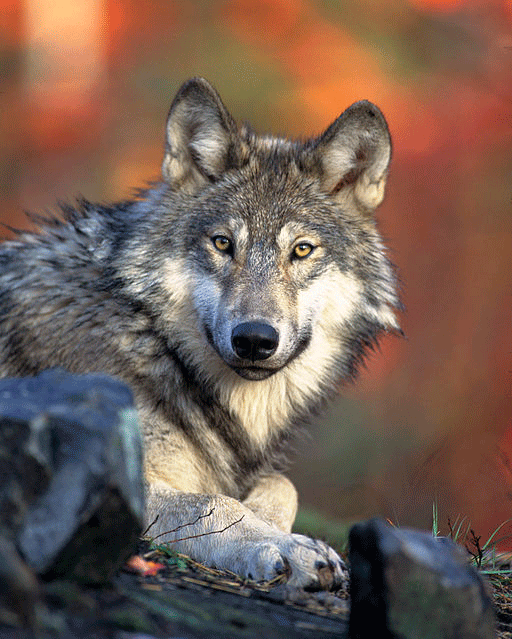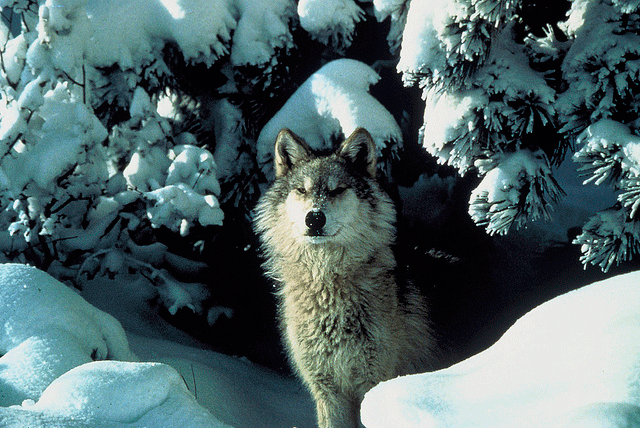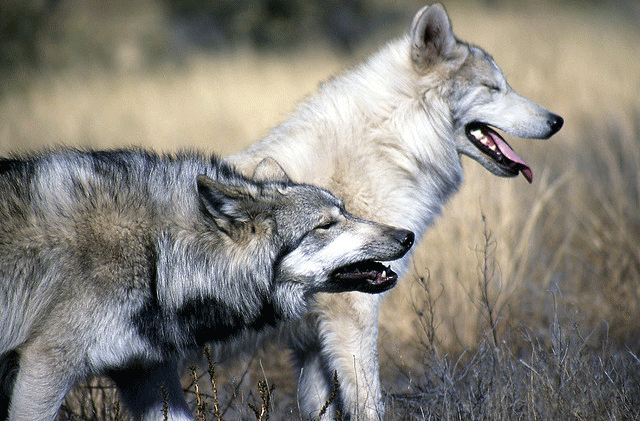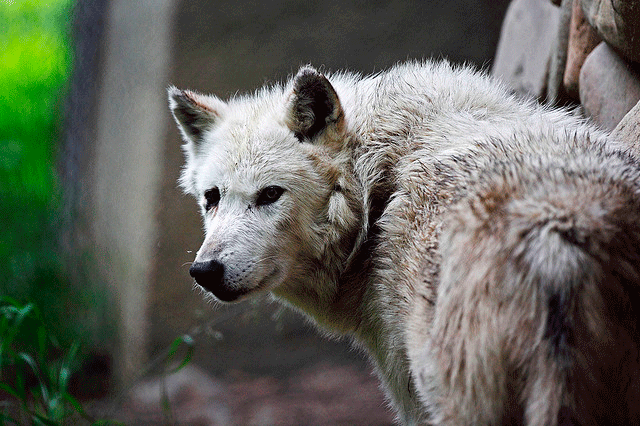Poor Science? Gray Wolf to Lose Federal Protection
Air Date: Week of February 28, 2014

Gray wolf laying (Photo: Gary Kramer, Wikimedia Commons)
A Fish & Wildlife Service report would justify dropping federal protection of the gray wolf on the basis of reclassification of the Eastern population. Geneticist Bob Wayne and Steve Curwood discuss the scientific shortcomings of this report and its repercussions on one of America’s top predators.
Transcript
CURWOOD: Packs of gray wolves once roamed widely across North America. But Europeans settlers cast wolves as destructive vermin that should be wiped out, and during the twentieth century, they nearly were. Gradually opinions changed. In 1974, wolves were protected under the Endangered Species Act, and in the 1990s they were successfully re-introduced into the northern Rockies.
Over the last three years wolves have been delisted in most northwestern states, and the US Fish and Wildlife Service now proposes to remove protection altogether. But gray wolves are still missing from much of their historic range, and an independent review panel says the move is premature. Bob Wayne, conservation geneticist at UCLA, was one of the reviewers. Hi there, Bob.
WAYNE: Hey there.
CURWOOD: What’s the current situation of gray wolves in the US?
WAYNE: There are three so-called recovered populations in the American west, and various debate about whether they’ve really recovered or not, but they’ve been delisted by an act of Congress actually, a rider on a budget amendment. And then the bulk of wolves are actually in Minnesota Great Lakes area and they probably number more than 4,000.

CURWOOD: And what about the northeast?
WAYNE: Well, there’s nothing in the northeast so to speak of. There are larger canids that are coyote-like, but that may be crosses between coyotes and gray wolves.
CURWOOD: Now, what is the basis that the Fish and Wildlife Service is using for its decision to delist the Gray wolf for all of the US?
WAYNE: The usual procedure is to delist when you’re populations are recovered and they’ve met some kind of numerical target. In this case, they’re delisting because of a taxonomic change, and this taxonomic change involves reconsidering what the gray wolf is and especially the gray wolf and in the Great Lakes area and that inhabited the east coast historically as a different species Canis lycaon, the eastern wolf.
CURWOOD: Now for folks who don’t remember their biology, what’s taxonomic mean?
WAYNE: [LAUGHS] Taxonomic just means where its classified in the taxonomic hierarchy like dogs are often considered a kind of wolf Canus lupis, or canus is the genus name and lupis is the species name. In this case, the eastern wolf is considered a separate species with its own species name Canis lycaon. Previously all those wolves were considered a part of the gray wolf Canus lupis.
CURWOOD: So, how does this redefinition of the eastern wolf affect this whole delisting process?
WAYNE: Surprisingly it causes Canus lupis not to be listed because it’s an invalid taxon, that is, previously as listed in 1975, it contained the full range of gray wolves in the United States and Canada, and that also included the Great Lakes area and 22 eastern states. And so, if there was a different wolf living there during that time, in other words, Canus lycaon, was never listed as an endangered entity, and so, therefore, whatever wolf is living in the east coast and the Great Lakes area isn’t protected under the Endangered Species Act.
CURWOOD: When was the last time the Fish and Wildlife Service delisted a critter because they changed the taxonomy?
WAYNE: I can’t think of any example, and so this sets a very dangerous precedent in my view, and to me it’s a bit taxonomic slight of hand that clearly the evidence isn’t strong enough for doing this kind of very dramatic action and that was the unanimous view of the panel.
CURWOOD: What is the science behind this declaration that there is this new wolf?
WAYNE: Well, it’s controversial. The funny thing about the composition of this panel was it was myself who represents a group who feels the Eastern wolf is not a distinct species, but just an interesting variety of the Gray wolf, and my, let’s say, opponent, Paul Wilson, was also on the panel, who recognizes the Eastern wolf as a distinct species, and we were both in agreement that it was premature to make any taxonomic decisions now.
CURWOOD: What kind of information were you folks on the panel presented with?

Two gray wolves (Photo: Caninest, Flickr Creative Commons 2.0)
WAYNE: US Fish and Wildlife Service put together a panel of biologists, and they wrote a long review that made the argument that this was a separate species on the East Coast, and published it in a Fish and Wildlife Service journal called Flora and Fauna that hasn’t published anything since 1991. So they kind of reinvigorated this journal to publish this long review. So we were provided that, and then a proposed rule change that delisted the Eastern wolf - it was published in the Federal Register - that largely just repeated the arguments in this huge review published in Flora and Fauna. That was our principal material that was provided to us, and we were to judge whether the arguments were scientifically valid, and we felt that they did not represent the best science. And I also think we’re in agreement also we’re sort of on the cusp of producing new studies that like in humans use complete genome sequence information to provide a much more definitive picture and test the hypothesis that this eastern form is really different.
CURWOOD: Action had been taken to try to begin reintroducing the wolf in Maine. What would it have done?
WAYNE: I think the Gray wolf, when reintroduced back into Yellowstone, everyone agrees that there was a dramatic ecological effect of reintroduction to gray wolves. They controlled elk, they changed elk behavior that grazing pressure, brought back trees, changed the whole trophic structure of the Yellowstone eco-system. That’s what many people believe. I think such beneficial changes might occur in the east coast as well. I used to live in Massachusetts, and there’s clearly a deer problem there. And to think that gray wolves could be reintroduced to parts of New England and New York and that potentially they would add some biological control, change habitats, I think that’s pretty exciting.

Wolf looking back (Photo: Todd Ryburn, Flickr Creative Commons)
CURWOOD: Bob Wayne is a conservation geneticist at UC Los Angeles. Thank you so much for taking the time with me today.
WAYNE: You're welcome. Glad to do it.
Links
Living on Earth wants to hear from you!
Living on Earth
62 Calef Highway, Suite 212
Lee, NH 03861
Telephone: 617-287-4121
E-mail: comments@loe.org
Newsletter [Click here]
Donate to Living on Earth!
Living on Earth is an independent media program and relies entirely on contributions from listeners and institutions supporting public service. Please donate now to preserve an independent environmental voice.
NewsletterLiving on Earth offers a weekly delivery of the show's rundown to your mailbox. Sign up for our newsletter today!
 Sailors For The Sea: Be the change you want to sea.
Sailors For The Sea: Be the change you want to sea.
 The Grantham Foundation for the Protection of the Environment: Committed to protecting and improving the health of the global environment.
The Grantham Foundation for the Protection of the Environment: Committed to protecting and improving the health of the global environment.
 Contribute to Living on Earth and receive, as our gift to you, an archival print of one of Mark Seth Lender's extraordinary wildlife photographs. Follow the link to see Mark's current collection of photographs.
Contribute to Living on Earth and receive, as our gift to you, an archival print of one of Mark Seth Lender's extraordinary wildlife photographs. Follow the link to see Mark's current collection of photographs.
 Buy a signed copy of Mark Seth Lender's book Smeagull the Seagull & support Living on Earth
Buy a signed copy of Mark Seth Lender's book Smeagull the Seagull & support Living on Earth

